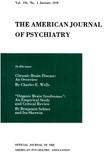THE INCIDENCE OF NAIL-BITING AMONG ADULTS
Abstract
A consecutive series of white naval recruits, consisting of 6946 men ranging in age from 17 through 37, was interrogated about and observed for the nail-biting mannerism. Of this group, tallies were kept for 4649 men in order to determine age-frequency characteristics. A group of 200 men were studied in more detail. One hundred of these were addicted to the habit. The following statements summarize the results that obtained.
1. Approximately 21.5 percent of the 6946 men were nail-biters.
2. The incidence-age curve for the nail-biting attribute reveals a secular trend when the data are viewed historically. A rapid increment in frequency from the age of 3 to the age of 15 (Wechsler data) exists. A gradual decrement from the age of i6 through 37 follows.
3. Evidence suggests that the application of the early Freudian theory of psychosexual development to these findings conceals more than it reveals.
4. A tentative, working hypothesis is suggested whereby the nail-biting mannerism is regarded as a tension-reducing mechanism acquired, for the most part, unconsciously.
5. The specific explanation for the habit rests upon the careful, clinical study of the individual personality. Only in this way can the dynamics of the mannerism be fully understood.
Access content
To read the fulltext, please use one of the options below to sign in or purchase access.- Personal login
- Institutional Login
- Sign in via OpenAthens
- Register for access
-
Please login/register if you wish to pair your device and check access availability.
Not a subscriber?
PsychiatryOnline subscription options offer access to the DSM-5 library, books, journals, CME, and patient resources. This all-in-one virtual library provides psychiatrists and mental health professionals with key resources for diagnosis, treatment, research, and professional development.
Need more help? PsychiatryOnline Customer Service may be reached by emailing [email protected] or by calling 800-368-5777 (in the U.S.) or 703-907-7322 (outside the U.S.).



